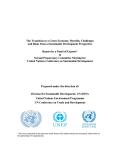The study has found that there is no existing Voluntary Carbon Standard (VCM) in Vietnam but that opportunities exist for poverty reduction projects to derive a source of funding from the international VCMs. It is however impossible at this point in time to quantify the scale of the opportunity as VCMs are in their nascent stages of development and represent a fickle and unreliable income stream that fluctuates significantly with the economy and voluntary sales and prices have declined significantly since the economic crash.

This report comprises a series of three perspectives of the ‘Green Economy’ from leading experts Jose Antonio Ocampo, Aaron Cosbey and Martin Khor and an overarching summary by Jose Antonio Ocampo. The core elements of the paper are:
With new and emerging technologies, shifts in employment and changes in the workforce are occurring across the world. Employment shifts driven by economic transformation occur at three different levels: (i) across sectors (or industries); (ii) across enterprises within the same or similar sector (industry); and (iii) within enterprises. The speed and the amplitude of job creation and loss across these three levels determine the effects on the number of jobs as well as income.
One of the key challenges facing policymakers in transforming their economies is creating decent and meaningful employment. According to the International Labour Organization (ILO), over 600 million new jobs would be needed in the next 10 years. This paper highlights employment opportunities and key challenges in a transition to a green economy and suggests what policy measures need to be put in place to ensure that newly created jobs can become decent jobs.
Green economy policies, if properly designed, deliver social and economic benefits by improving resource efficiency and inducing domestic companies to innovate, which may provide them with a competitive edge – first mover advantage – vis-à-vis their competitors.
Korea, which has had the highest growth rate of greenhouse gas emissions in the OECD area since 1990, adopted an ambitious Green Growth Strategy in 2009. It aims at reducing emissions by 30% by 2020 relative to a "business as usual" scenario, implying a 4% cut from the 2005 level. The Strategy also includes a Five-Year Plan with public spending of 2% of GDP per year to promote green growth. Korea is planning to establish a carbon price through a cap-and-trade emissions trading scheme. Such an approach, combined with a carbon tax in sectors not covered by the scheme, is necessary to reduce emissions in a cost-effective manner and foster innovation in green technology. In addition, each sector should face the same electricity price based on production costs to promote efficient energy use. Given market failures, the government has a role to play in green R&D, particularly for basic research, in fostering green finance and in developing renewable energy resources.
